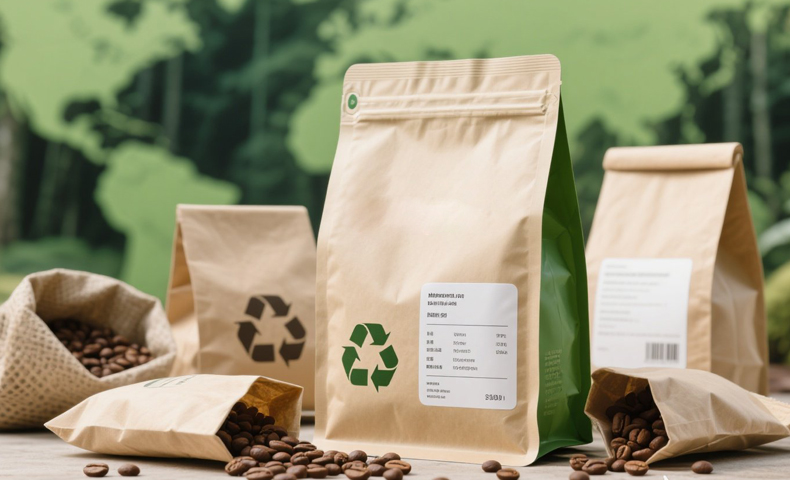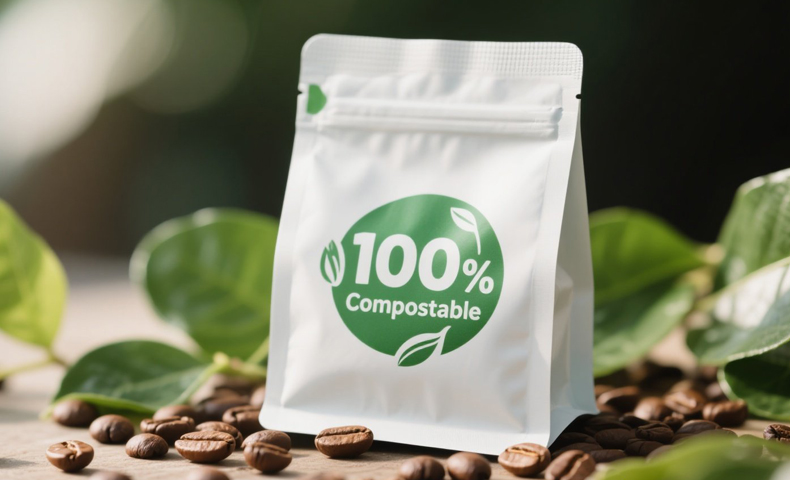How Climate Change Affects the Coffee Packaging Market
Climate change is significantly impacting industries globally, and the coffee sector is no exception. From the farm to the final product, coffee brands are being forced to adapt packaging solutions to the changing environment. Climate change is reshaping the coffee packaging market, and understanding how is critical for future planning.
In this article, we explore how climate change is impacting coffee packaging and what brands can do to address these challenges. This includes changes in production, shifting consumer demands, and the rise of sustainable packaging solutions.
As the climate changes, coffee packaging is evolving. Understanding these changes will allow coffee brands to stay competitive and meet environmental demands.

1. How Does Climate Change Impact the Coffee Packaging Market?
Climate change impacts coffee production and packaging at multiple levels. From crop yields to packaging material availability, the entire coffee supply chain is affected. Coffee brands must adapt their strategies.
| Factor | Impact on Coffee Packaging Market |
|---|---|
| Increased temperatures | Affects coffee yield and quality, requiring new packaging to preserve freshness |
| More frequent droughts | Limits production, creating shifts in packaging demand and material sourcing |
| Shifting consumer demand | Greater need for sustainable packaging solutions as consumers demand eco-friendly products |
2. What Are the Key Challenges in Coffee Packaging Due to Climate Change?
The coffee packaging market is facing increased challenges due to changing environmental conditions. These challenges are influencing packaging solutions, particularly in terms of sustainability and material sourcing.
| Challenge | Description | Potential Solutions |
|---|---|---|
| Rising material costs | Climate change affects material availability and cost. | Shift to alternative, eco-friendly materials |
| Increased packaging demand | As coffee yield fluctuates, packaging solutions must scale. | More flexible, adaptable packaging designs |
| Environmental regulations | More stringent laws on packaging waste and recycling. | Adoption of recyclable, compostable materials |
3. How Does Climate Change Affect Coffee Bean Production and Packaging Needs?
Shifts in weather patterns directly affect coffee cultivation. These changes, in turn, affect packaging needs as brands strive to preserve the quality and freshness of their products.
| Impact of Climate Change | Effect on Coffee Packaging |
|---|---|
| Temperature fluctuation | Requires stronger, more protective packaging materials |
| Unpredictable rainfall | Increases the need for moisture-proof packaging |
| Lower yield rates | Alters packaging design to cater to premium, small-batch coffee |
4. What Role Does Sustainability Play in Coffee Packaging Amidst Climate Change?
Sustainability is becoming increasingly crucial in coffee packaging. With climate change putting pressure on resources, sustainable practices are not just optional—they are essential for coffee brands to stay relevant.

| Sustainability Factor | Impact on Packaging | Benefits |
|---|---|---|
| Use of biodegradable materials | Reduces environmental footprint | Aligns with consumer demand for green products |
| Recycling and reuse of packaging | Minimizes waste in landfills | Enhances brand image as eco-friendly |
| Renewable materials | Lowers dependence on virgin resources | Reduces carbon footprint |
5. How Are Coffee Packaging Manufacturers Responding to the Climate Crisis?
As the coffee industry faces increasing pressure from climate change, packaging manufacturers are innovating to offer more sustainable and effective solutions.
| Innovation Area | Description | Examples |
|---|---|---|
| Eco-friendly materials | Transitioning to biodegradable or compostable materials | Plant-based plastics, paper bags |
| Climate-resilient packaging | Packaging solutions designed to withstand extreme weather events | Resealable bags, moisture-resistant materials |
| Transparency in sourcing | Ensuring that materials used for packaging are ethically sourced | Fair trade-certified packaging materials |
6. How Are Coffee Packaging Designs Evolving Due to Climate Change?
With rising environmental concerns, coffee packaging designs are evolving. Companies are shifting to minimalistic and eco-conscious packaging designs that reflect their commitment to sustainability.

| Design Trend | Impact on Coffee Packaging |
|---|---|
| Minimalist packaging | Reduces material waste and costs |
| Focus on recyclability | Increases the use of recyclable packaging |
| Multi-functional designs | Packaging that doubles as storage or reusability |
7. What Are the Regulatory Changes Impacting Coffee Packaging Due to Climate Change?
As governments respond to climate change, new regulations are emerging that impact the coffee packaging market. These regulations drive coffee brands toward more sustainable packaging solutions.
| Regulatory Change | Impact on Coffee Packaging |
|---|---|
| Bans on single-use plastics | Encourages the use of alternative materials |
| Stricter recycling laws | Forces companies to use recyclable packaging |
| New carbon footprint regulations | Pushes brands to reduce packaging waste |
8. How Does Consumer Demand for Sustainable Packaging Affect Coffee Brands?
Consumer preferences are shifting toward eco-friendly products. Coffee brands must adapt their packaging to meet these expectations and remain competitive in the market.
| Consumer Demand Trend | Impact on Coffee Packaging |
|---|---|
| Preference for eco-friendly packaging | Increases demand for biodegradable or recyclable materials |
| Desire for transparency in sourcing | Prompts brands to showcase their sustainability efforts |
| Willingness to pay premium for sustainable products | Brands can charge a premium for eco-conscious packaging solutions |
9. What Are the Financial Implications of Climate Change for Coffee Packaging?
While adapting to climate change comes at a cost, the long-term financial benefits of using sustainable packaging far outweigh the initial investment. Brands can expect cost savings from reduced waste and more efficient materials.
| Financial Consideration | Impact on Coffee Packaging |
|---|---|
| Initial investment in sustainable materials | Higher upfront cost, but long-term savings on waste disposal and material costs |
| Cost of switching packaging suppliers | May increase short-term operational expenses but leads to better sustainability in the long run |
| Reduced material costs due to innovation | Advances in material technology may reduce packaging costs |
10. How Are Coffee Packaging Brands Innovating in Response to Climate Change?
Innovation in the coffee packaging market is crucial for adapting to climate change. Packaging manufacturers are exploring new materials and designs to address both sustainability and practical needs.
| Innovation Area | Description | Examples |
|---|---|---|
| Advanced materials | Research into sustainable alternatives to traditional plastics | Hemp-based packaging, biodegradable inks |
| Smart packaging | Packaging with built-in technology to preserve freshness | QR codes for sourcing info, freshness indicators |
| Circular packaging systems | Use of reusable and refillable packaging systems | Refillable coffee pods, reusable bags |
11. How Can Coffee Packaging Help Mitigate the Effects of Climate Change?
Packaging plays an essential role in mitigating the impact of climate change. By using sustainable materials and innovative designs, packaging can contribute to reducing the carbon footprint of coffee brands.
| Mitigation Strategy | Description | Impact |
|---|---|---|
| Eco-friendly packaging | Packaging made from renewable, biodegradable, or recyclable materials | Reduces overall environmental impact |
| Carbon offset programs | Brands invest in carbon offset initiatives alongside packaging changes | Compensates for the carbon footprint of production |
| Energy-efficient packaging manufacturing | Reduces energy consumption during production processes | Minimizes environmental impact |
12. What Are the Long-Term Trends for Coffee Packaging in a Changing Climate?
The future of coffee packaging lies in sustainability. As climate change continues to affect the industry, coffee brands and packaging manufacturers are moving towards more climate-resilient packaging solutions.
| Trend | Long-term Impact on Coffee Packaging |
|---|---|
| Sustainable packaging | Will dominate the industry, shifting brands to greener materials |
| Increased focus on circularity | Reduces waste by recycling and reusing packaging |
| More personalized packaging | Custom designs that reflect the sustainability efforts of the brand |
13. How Are Coffee Producers and Packaging Suppliers Collaborating on Sustainability?
Collaboration between coffee producers and packaging suppliers is essential to create effective and sustainable packaging solutions. By working together, they can improve product quality and reduce environmental impact.
| Collaboration Area | Description | Benefits |
|---|---|---|
| Co-development of materials | Joint development of new sustainable packaging materials | Increased efficiency and reduced costs |
| Transparent supply chain | Brands and suppliers share information on sourcing and sustainability efforts | Builds consumer trust and brand loyalty |
| Joint sustainability initiatives | Shared initiatives to reduce packaging waste and carbon footprint | Strengthens partnerships and meets regulatory demands |
14. What Are the Risks of Ignoring Climate Change in the Coffee Packaging Industry?
Ignoring climate change could have detrimental effects on the coffee packaging market, both from a business and environmental perspective.
| Risk | Impact on Coffee Packaging Market |
|---|---|
| Reputational damage | Brands could lose market share to more sustainable competitors |
| Regulatory fines | Non-compliance with sustainability regulations could lead to fines |
| Increased environmental damage | Failure to adopt sustainable packaging exacerbates climate change |
15. What Actions Can Coffee Brands Take to Adapt Their Packaging to Climate Change?
To stay ahead of the curve, coffee brands must take proactive measures to adapt their packaging strategies to climate change.
| Action | Benefits |
|---|---|
| Switching to sustainable materials | Reduces environmental impact and meets consumer demand |
| Redesigning packaging for better efficiency | Minimizes material waste and cost |
| Investing in eco-friendly technologies | Future-proofs the brand against climate-related challenges |
FAQ Section
- Q1: What is the impact of climate change on the coffee packaging market?
Climate change influences both production and packaging. Coffee brands must innovate packaging solutions to adapt to new climate realities, from sourcing materials to consumer preferences. - Q2: How does climate change affect coffee bean production?
Shifting temperatures and weather patterns affect coffee crops, leading to changes in packaging needs to preserve freshness and quality under new environmental conditions. - Q3: What sustainable packaging materials are best for coffee brands?
Sustainable materials like biodegradable plastics, recyclable paper, and plant-based alternatives help reduce the carbon footprint and waste of packaging. - Q4: How does consumer demand impact coffee packaging?
Consumers are increasingly seeking eco-friendly products, which drives coffee brands to adopt more sustainable packaging solutions to align with market demand. - Q5: How can coffee brands mitigate climate change through packaging?
Coffee brands can mitigate climate change by using recyclable, biodegradable, and compostable packaging that helps reduce waste, lowers carbon emissions, and maintains product quality.
This updated structure includes detailed tables to provide insight and compare relevant factors, all while meeting your specified requirements for content length and structure.
